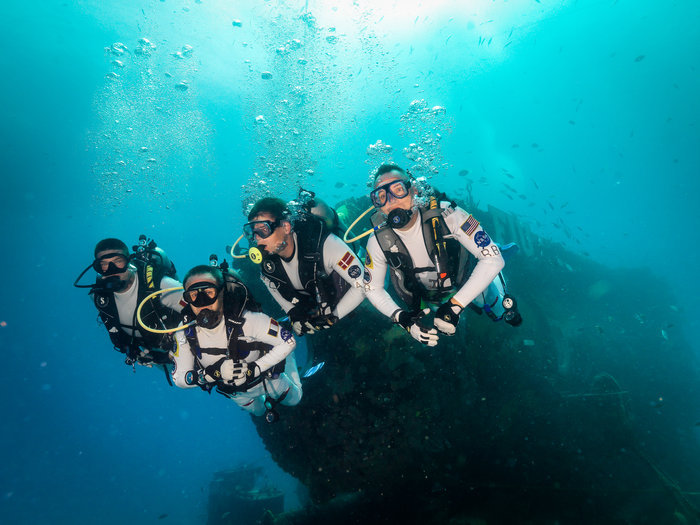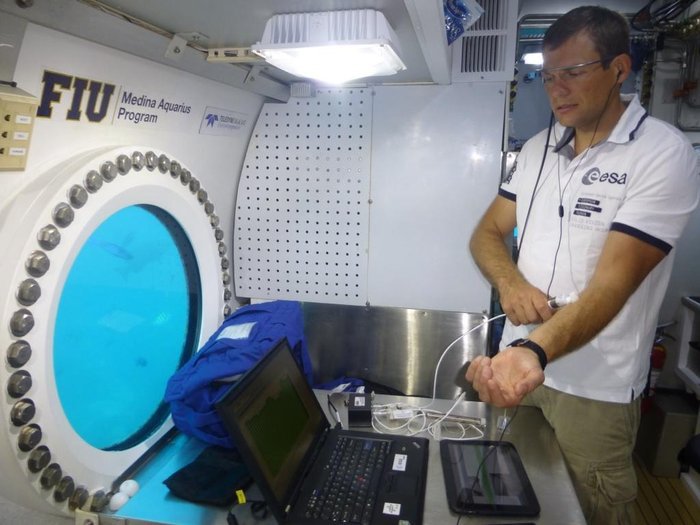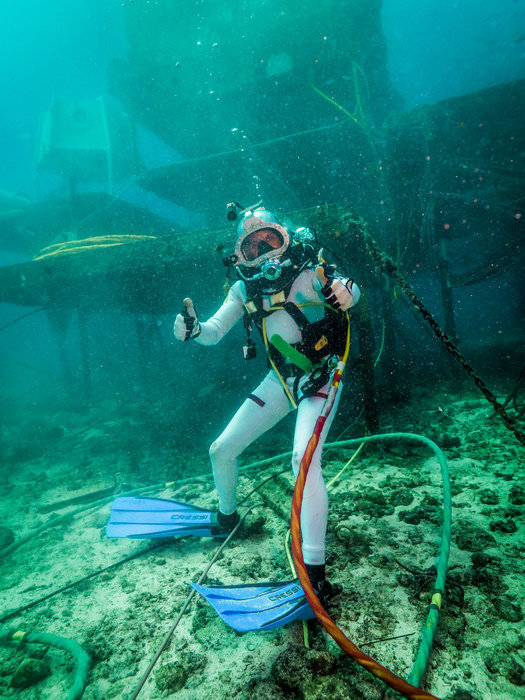The most "ordinary" space gadgets
- Transfer

What could be more interesting than space technology? After all, these are the things that we most likely will only read, watch photos and films in our lives. Only a few will be able to touch the spaceship and go to zero gravity. However, all technological innovations that are used outside of our planet, are first tested on Earth. And to be more precise, then in the water.
Astronaut Andreas Mogensen is looking forward to his flight to the ISS next year, but now he is testing a new gadget underwater, which he will then use in space. NASA has special underwater training missions. They pass off the coast of Florida, at a depth of 20 meters. An impromptu space base was created there, on which regular scuba diving exercises take place.
Well, of course, this base called Aquarius is perfect not only for training astronauts, but also for testing equipment that will go into space.

Here, for example, a device in order to perform various operations without the help of hands. Doesn’t resemble anything? It is called MobiPV (Mobile procedure viewer) and is based on commercial devices such as Google Glass, smartphones and tablets. However, there is still much more emphasis on reliability and fault tolerance. The main goal now is to understand how mobiPV can increase the performance of astronauts, eliminating the need to break away from any process to get advice or see instructions. In addition, mobiPV is designed so that the team on Earth can help the astronaut in real time. After all, if desired, they will even see what the person who is wearing this device sees.
The lead engineer for this project explains that the goal is to make people more connected. So that the team from Earth could help the astronaut and be as if behind his shoulder, supporting him step by step.
As you can see, this gadget is very similar to Google Glass, but the software here, of course, is more specific. Nevertheless, this is how modern technologies that already surround us everywhere exist in space. So far, Andreas Mogensen is testing mobiPV underwater, creating various situations and analyzing how the gadget works. However, already next year he will fly to the ISS and who knows, maybe we can also observe his work, thanks to modern technologies.
However, Google Glass is still the gadget that not everyone has. Let’s see what the astronauts use, what everyone has in the house. After all, they probably have smartphones, laptops, game consoles there (after all, in space it is very boring) ...
Of course, astronauts use laptops. The first laptop flew into orbit back in 1985 and it was a Grid Compass. Then, in 1991, another device, the Mac Portable, was spotted on the Atlantis shuttle. However, from 1993 to this day, the ThinkPad has been used in space, formerly by IBM, and now by Lenovo. It is worth noting that the ThinkPad are generally the only certified laptops for use on the ISS.
Not in space and without modern Apple technology. An iPod was on board the International Space Station in 2005, and in 2011 astronauts begged NASA for an iPad 2, and they need to play something in Angry Birds. Were at the station and iPhone, it is reliably known about the model of the 4th version. But the first Android-smartphone was Google Nexus S. By the way, a couple of Sphere robots are now working on them, which measure the level of noise and radiation at the station.

But with regard to cameras, then NASA takes the same principled position as in the case of laptops. Photographic equipment aboard the ISS from Nikon only. And now they are doing it in a white case, so as not to overheat. At the station there are now about a dozen different SLR cameras, all of them, of course, top-end modifications. Nikon’s particular pride is that they didn’t have to change the cameras much to work in space, they say that everything works out of the box.
Modern social networks are not alien to astronauts. So, for example, our Oleg Artemyev posted on Instagram photos of different cities, taken directly from the ISS. Moreover, this idea was so liked by people that they asked him to take a photo even after Oleg safely returned to Earth. But Canadian astronaut Chris Hadfield is actively promoting himself on Youtube. He asked the audience what he would do in weightlessness to make it interesting. Someone asked him to wet and squeeze a rag. Think about it, on Earth this is a primitive task, but what to do where there is also water from a tube? The video quickly scattered across the Internet, because everyone is interested in how familiar things are done where only the elite get to.
Astronauts spend a lot of time in orbit, doing various scientific things. And if they are unlikely to have to squeeze the rags out there in a real situation, then cutting their hair is quite an ordinary task, not shagging (flying). And for this a special machine was created, combined with ... a vacuum cleaner. Because otherwise, all the hair will fly apart and can no longer be collected. Even nails in zero gravity are so easy not to cut, you have to do this over the air duct.
In general, as you see, the work of the astronaut is amazing and beautiful. And this is because we talked only about those technologies and phenomena that are similar to our everyday life. And just imagine how many zero-gravity and aboard the same ISS unique devices and devices. Devices that only remotely resemble terrestrial counterparts. Sports simulators, toilet and much more. But about it somehow next time. In the meantime, we wish good luck to Andreas Mogensen, who already in 2015 will fall into this magical world. By the way, on Youtube he has a rather interesting video blog that you can subscribe to.
Good luck
